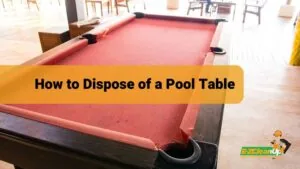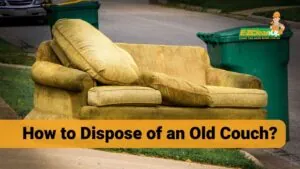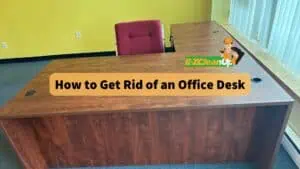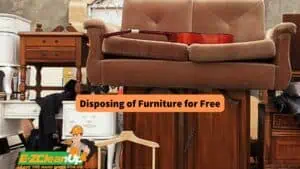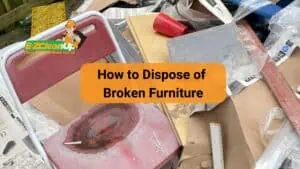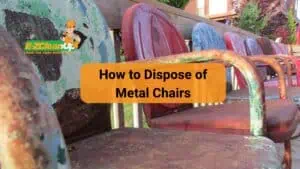To disassemble a couch, start by removing cushions and upholstery and identifying and unscrewing connective elements like bolts and screws. Carefully dismantle the frame and organize all parts for easy reassembly or disposal.
Discover more detailed steps in our comprehensive guide on how to disassemble a couch in the article below.
Removing Cushions and Upholstery
Disassembling a couch is easier when you do it in parts. This will ensure you maintain the integrity of the furniture, and you won’t find it difficult to reassemble, especially when you’re planning to reupholster or simply clean the cushions.
Step-by-Step Guide to Removing Cushions
To start, remove the cushions from your couch. Most cushions can be lifted off easily, but some may be attached with Velcro or zippers. If your couch has attached cushions, look for a zipper along the underside of each cushion, as this provides easy access to the cushion stuffing. If you are moving to another place, then you need to be extra careful during this process so you can make sure the couch isn’t damaged.
For cushions without zippers, you may need to carefully open the seam using a seam ripper. This method should be done with care to avoid damage to the fabric.
After removing the cushions, set them aside in a safe place. Consider using a vacuum cleaner or lint roller to clean them, especially if they have accumulated dirt over time.
Tips for Safely Removing Upholstery
Begin by examining the couch for the location of staples and any design elements like buttons or cording. Remove the dust cover from the underside of the couch first. This is usually secured with staples, which can be removed with a staple remover.
Remove the old upholstery by loosening and removing the staples with needle-nose pliers or a screwdriver. Take pictures and notes of the order in which you remove the fabric pieces, as this will be helpful for reupholstering.
If you find that the upholstery is not easily accessible, you may need to fully remove it to get to the cushion filling.
Organizing Removed Materials
Label each piece of fabric and cushion as you remove them. Use colored stickers or tape for easy identification. Take detailed pictures from different angles to help remember where each piece goes.
Store screws, bolts, and other small hardware in labeled plastic bags and tape them to the corresponding furniture piece if possible. Keeping all the parts organized in one place ensures that they are not mixed up with other items and simplifies the process of reassembling or reupholstering the couch.
Steps to Dismantle the Frame
Here are the steps to follow on how to take apart a couch when it’s time to dismantle the frame:
Step 1: Identify Connective Elements (Screws, Bolts, etc.)
The connective elements that hold the frame together typically include screws, bolts, and sometimes nails. The type and placement of these connectors can vary depending on the couch’s design and manufacturer.
It’s important to locate all of these elements before proceeding, as missing any could make the disassembly process more difficult. A screwdriver or drill with a Phillips head attachment is usually the primary tool needed for this task. In some cases, pliers or a hammer may also be required for removing stubborn fasteners.
Step 2: Disconnecting the Cushions and Arms
Disconnect the cushions from the frame using a screwdriver or hammer, depending on whether the cushions are screwed or nailed to the frame. Next, focus on removing the arms of the couch, which are typically attached with screws—two per side in most cases.
Step 3: Separate the Main Frame from the Seat
This involves unscrewing the screws that hold the frame to the back support and seat. It’s essential to be careful during this process to avoid breaking any small metal tabs or connectors. The frame should then lift off easily. If it doesn’t, ensure all bolts or connectors are removed, and don’t force the frame apart.
Step 4: Handling and Storing Disassembled Parts
Once the frame is dismantled, it’s crucial to handle and store the disassembled parts properly. Each part should be labeled and organized to facilitate easy reassembly. Consider taking photos of each step of the disassembly process to serve as a guide for putting the couch back together.
Smaller hardware, like screws and bolts, should be stored in labeled bags or containers. If you plan to dispose of the couch, consider recycling options. Separate the materials into different categories: fabric, foam, metal, and wood.
Metal components can usually be recycled at scrap metal dealers, while untreated wood can be recycled or composted. Foam and fabric might be trickier to recycle and may require finding specialized facilities. Always check with your local recycling center for specific guidelines.
Importance of Proper Couch Disassembly
Learning how to break down a couch is more than just a step in moving or disposing of it; it’s a crucial process that ensures the longevity and integrity of the furniture. Proper disassembly minimizes damage, making it easier to move the couch through tight spaces and transport it safely.
It also enables efficient recycling or disposal, aligning with eco-friendly practices. By carefully disassembling the couch, you preserve its components for future use or recycling.
Safety Considerations and Tools Needed
Use the right tools, like screwdrivers, pliers, and a hammer or mallet, to safely dismantle the furniture. Gloves and protective eyewear can prevent injuries. Enlisting help from others not only makes the process easier but also safer, as it helps in handling heavy and awkward parts.
Additionally, if any broken or damaged parts are discovered, it’s important to repair them before reassembling them to maintain the integrity of the couch. Finally, wrapping and protecting the disassembled parts properly ensures they are not damaged during transport. This will preserve their condition for future use.
Preparing for Disassembly
For a safe and efficient disassembly process, it is crucial to prepare for it.
Identifying the Type of Couch
Knowing your couch type is essential for a smooth disassembly. Common types include sectional sofas, futons, loveseats, recliners, and U-shaped sofas. Each type has its own unique structure and disassembly method.
For instance, sectional sofas and U-shaped sofas might have clasp or snap technology for easy separation of pieces. Recliners, on the other hand, might require additional steps to dismantle the reclining mechanism. Recognizing these differences ensures that you approach the disassembly process correctly and efficiently.
Clearing the Area and Gathering Tools
Before you start, clear the area around the couch to provide sufficient space for disassembly. This step is crucial to avoiding damage to your home or the couch itself. Once the area is clear, gather the necessary tools.
A flathead screwdriver, Phillips screwdriver, and staple remover are commonly needed. Having these tools at hand ensures that you’re prepared for any screws, bolts, or staples you might encounter during the disassembly process. Additionally, keep a container or bag nearby to store small parts and hardware, preventing loss and confusion during reassembly.
Initial Steps Before Disassembly
Start by removing all cushions and pillows. This step gives you a better view of the couch’s structure and allows for easier access to the frame. Check for any hidden screws or fasteners, especially if cushions are attached with Velcro or zippers. Once the soft furnishings are removed, use a vacuum cleaner or lint roller to clean them. This is also a good opportunity to inspect their condition and consider replacing them if they are worn out or damaged.
Special Considerations for Different Couch Types
When disassembling different types of couches, such as sleeper sofas, recliners, and those with delicate or antique structures or integrated electronics, special considerations must be taken to ensure the process is done safely and efficiently.
Handling Sleeper Sofas and Recliners
For sleeper sofas, the process generally involves several steps:
- Start by removing the cushions, which might have zippers, Velcro, or be sewn in.
- Open out the sleeper sofa to access and remove the mattress and reveal the bed frame.
- Fold up the bed frame again to facilitate removal.
- Locate and unscrew the bolts or screws that are holding the bed frame in place. It’s easier to do this by tilting the bed frame or laying the sofa bed with its back on the floor for better access.
- After unscrewing, lift out the bed frame and set it aside.
- Proceed to unscrew the rest of the attached parts, like the sofa frame, arms, backrest, etc.
- Keep all screws and bolts safe and properly labeled for reassembly.
For Lazy Boy sleeper sofas, a similar approach is taken. You’ll need to remove the cushions, locate and unscrew the bolts, detach the sleeper mechanism, and then separate the sections of the sofa. Each section should be wrapped and transported carefully.
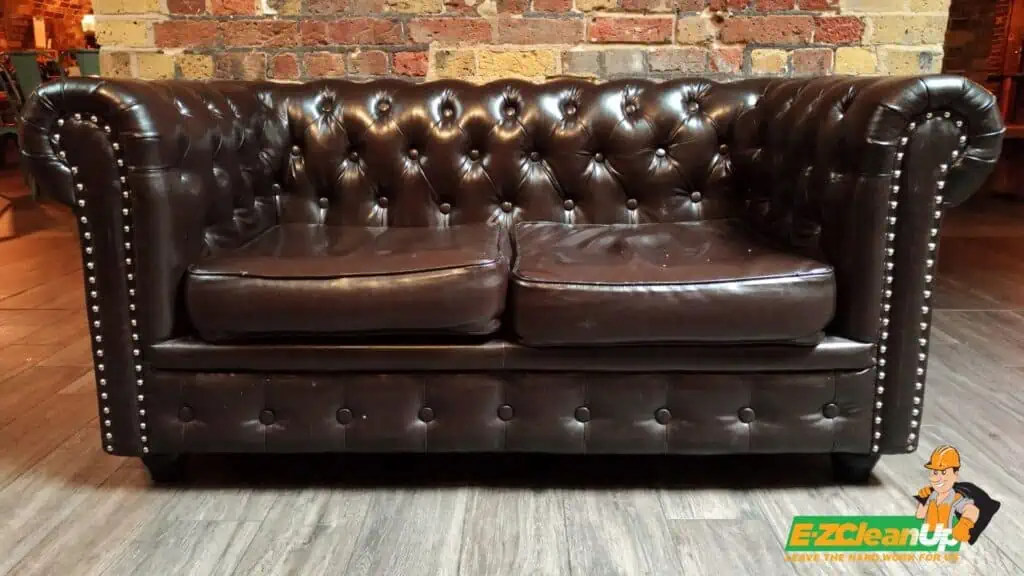
Dealing with Antique or Delicate Couches
Handling antique or delicate couches requires a gentle approach to avoid damage. Since these couches can have unique and fragile components, it’s essential to carefully assess how the couch is assembled before starting.
Look for any signs of wear that might affect how you disassemble it. Use appropriate tools and handle each part delicately, especially when dealing with old fabrics and stuffing that might be brittle or prone to tearing.
Disassembling Couches with Integrated Electronics
Couches with integrated electronics, such as those with built-in recliners or sound systems, require extra caution. Before beginning disassembly, ensure all electronic components are disconnected from power sources.
Carefully locate and disconnect any wiring harnesses or electronic components. It’s important to note where each electronic component fits into the couch to ensure correct reassembly. Use a systematic approach to remove the electronic elements and store them safely during the move.
Disposal and Recycling of Couch Parts
When it comes to the disposal and recycling of couch parts, there are several eco-friendly options and best practices to consider. It’s essential to assess the condition of your couch and decide on the most appropriate disposal method.
Eco-Friendly Disposal Options
Donation: If your couch is still in good shape, consider donating it to organizations like the Salvation Army, Goodwill, or Habitat for Humanity. These organizations often resell donated furniture to fund their community work or provide it to families in need. Some may even offer pickup services for your convenience.
- Recycle Your Couch: Recycling is a responsible choice to prevent your couch from ending up in a landfill. Many cities have eco-friendly recycling programs where sofas are broken down and their materials, such as wood and metal, are recycled. You may need to transport the couch to a recycling center, and some centers may charge a fee for this service.
- Professional Junk Removal Services: These services can remove your couch for a fee. For example, at EZ CleanUp, we charge by volume. A 1/8 truck load of junk is priced at $150, and a full truck load is priced at $599. Check our website for updated price listings.

Tips for Recycling and Repurposing Materials
- DIY Recycling: For those who enjoy DIY projects, you can dismantle the couch yourself and separate its materials for recycling. Wood, foam, fabric, and metal can often be recycled at appropriate facilities. Remember to check with your local recycling center for specific guidelines on what materials they accept.
- Repurposing: Consider repurposing or upcycling parts of your couch. For example, wood frames can be used for other projects, and fabric can be reused for smaller upholstery projects or crafts.
- Selling or Giving Away Online: Platforms like Craigslist, Facebook Marketplace, or Nextdoor are great for selling or giving away your couch. This option works well if your couch is still in good condition and you’re looking to find it a new home.
Local Regulations and Best Practices
Before disposing of your couch, check local regulations and waste disposal policies. Some areas have specific guidelines for large-item disposal. Ensure the couch does not have any health hazards like bed bugs or mold, as these items are usually not accepted by donation centers or recycling facilities.
While taking your couch to a landfill is an option, it’s less eco-friendly due to the contribution to landfill waste. If you must use this method, be aware of the environmental impact and consider other options first.

EZ CleanUp: Your Expert Junk Removal Partner in Philadelphia
Disassembling a couch can be challenging, especially when you’re left with bulky parts to dispose of. This is where you can trust EZ CleanUp to handle the job. Based in Philadelphia, we are your local experts in junk removal. We offer an eco-friendly, cost-effective solution for removing unwanted furniture, including bulky old couches.
Not only do we help declutter your space, but we also ensure responsible disposal of your junk, prioritizing recycling and donations wherever possible.
Beyond just hauling away unwanted items, we offer a range of services, including dumpster rental, demolition, and even paying cash for junk cars. If your disposed items are still in good shape, we can sell or recycle them, crediting any proceeds back to you.
Ready to reclaim your space? Contact us today for a free on-site estimate, and let’s get started on your junk removal project.





